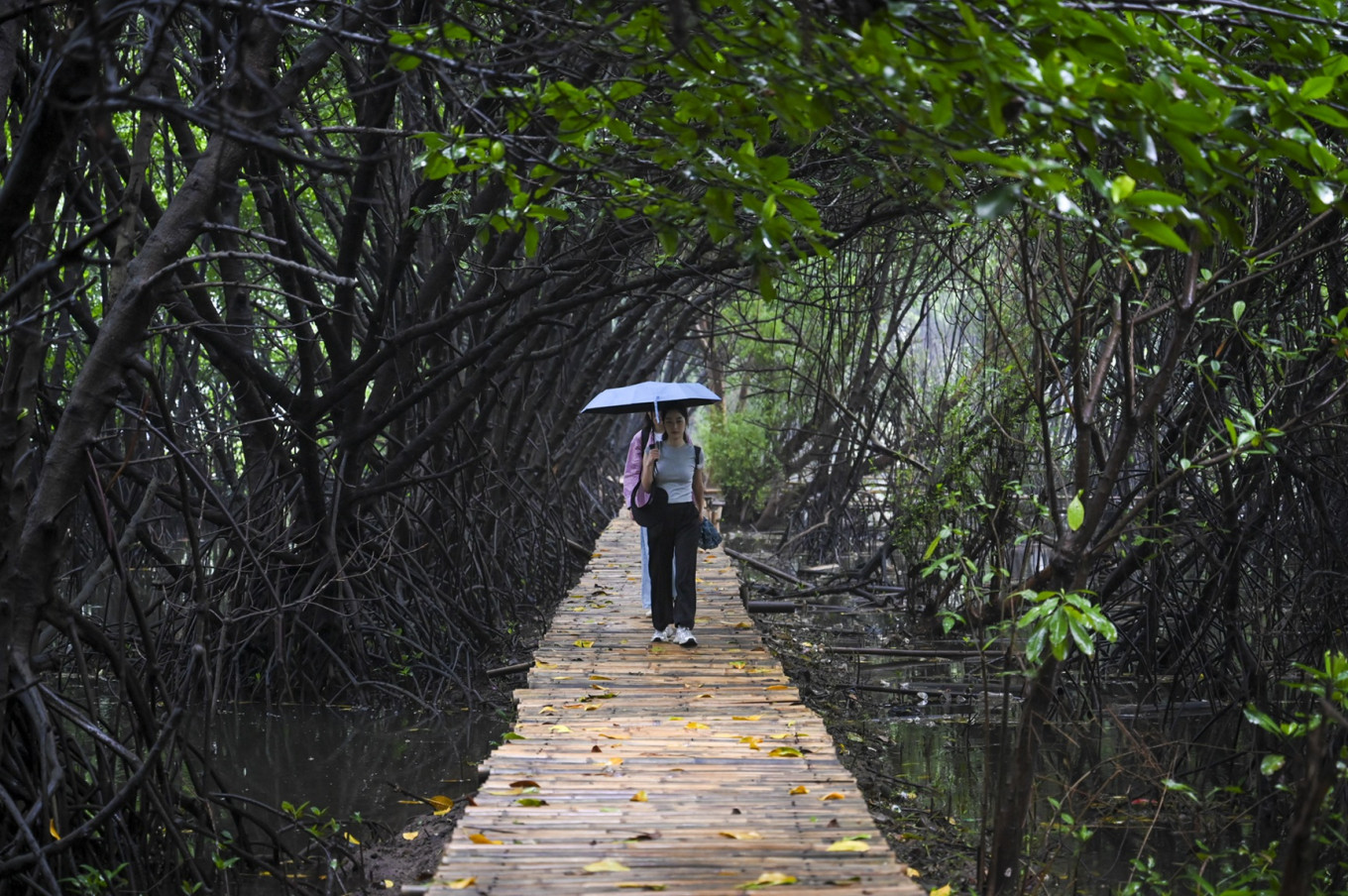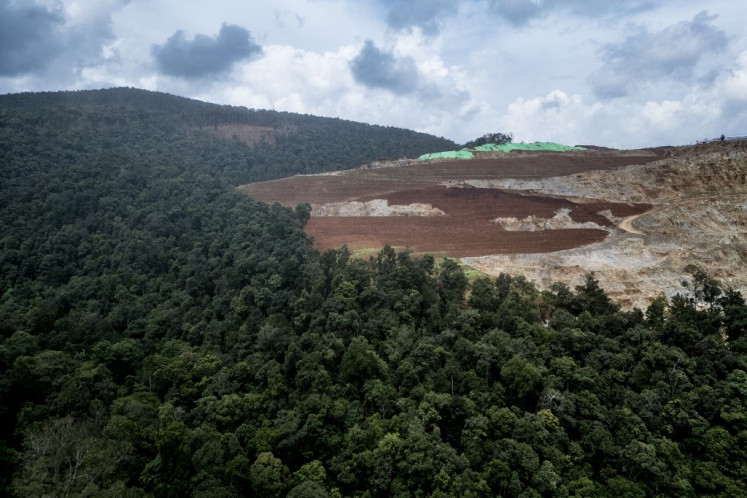Popular Reads
Top Results
Can't find what you're looking for?
View all search resultsPopular Reads
Top Results
Can't find what you're looking for?
View all search resultsPromising outcomes from the summit to conserve and restore mangroves
Mangroves are crucial to building climate resilience.
Change text size
Gift Premium Articles
to Anyone
M
angroves are one of the most threatened ecosystems on the planet. They store carbon from the atmosphere and act as a buffer from tropical storms and coastal erosion, so mangroves are crucial to building climate resilience.
More than 1 million hectares (ha) of mangroves have been lost since 1996, with about 70 percent of this loss considered restorable. But mature mangrove forests and their vast carbon stores are irreplaceable.
Protecting what we still have is paramount, alongside global efforts to plant more mangroves. So, I was excited to be at the world’s first international mangrove conservation and restoration conference in Abu Dhabi, United Arab Emirates, from Dec. 10 to 12.
A key focus of this three-day meeting, with more than 400 delegates plus 100 speakers from 82 countries, is the “mangrove breakthrough”. This is a new global strategy supported by the Global Mangrove Alliance, an organization that brings together technical experts, leaders, communities, businesses and funders to collaboratively scale up solutions.
This plan for mangrove conservation and restoration has three goals: To stop human-driven mangrove loss, double the area of mangroves with effective conservation status and restore half of recently lost mangroves.
Reflecting on the current status of world mangroves, Tom Worthington, an aquatic ecology researcher at the University of Cambridge, introduced an online platform called Global Mangrove Watch. This interactive tool uses remote sensing data to map mangrove habitats. It combines data on the geographical range and status of mangroves with information about their value as carbon stores.
“This provides open-access information to help plan mangrove conservation and restoration based on the best available global data sets,” Worthington said.
Meticulous planning and long-term monitoring is critical to track change and adapt where needed. Worthington hopes that, as the project progresses, more detailed data will become available. In the future, this could be reliably used by local projects monitoring small areas of coastline and revolutionize our understanding of the risks of ongoing habitat loss in some regions. It could also highlight where exactly more mangroves could be restored.
According to experts at the conference, most mass planting efforts fail to restore functional mangrove forests. We need a seascape and landscape approach that creates a corridor linking mangroves with sea grasses, corals and upstream rivers, so that ecosystems deliver multiple socioeconomic and ecological benefits.
I asked Elena Roddom, a technical advisor for mangrove restoration from charity Wetlands International about the apparent lack of consensus around the best ways to conserve mangroves.
“We are racing against the clock, with 50 percent of the world’s mangroves at risk of collapse by 2050 due to human-driven pressure. We cannot afford to lose these forests,” she told me. “They play a critical role in coastal resilience, food security, biodiversity protection climate change mitigation and adaptation.”
We urgently need to prioritize proven ways to restore mangroves. That involves a shift from mass planting to community-led mangrove restoration that is successful in the long-term.
Mangrove planting using the right species in the right place can assist natural regeneration. This will result in better survival, faster growth and a more diverse and resilient mangrove forest, as studies by Jurgenne Primavera, chief mangrove scientific advisor at the Zoological Society of London, show.
At this conference, I have seen fantastic examples of successful community-based mangrove restoration at scale in Indonesia, Guinea Bissau, Kenya, Mexico and the United States. There are lessons to learn from each one.
Judith Okello, chair of the National Mangrove Management Committee in Kenya, has been leading restoration efforts in the Lamu-Tana area and understands the importance of engaging local people in mangrove restoration.
She explained that Kenya’s Forest Conservation and Management Act (2016) ensures community involvement in forest management, through forest community associations that create a network of support. People are empowered to have their say and help guide the national mangrove plan organized by the Kenyan Forest Service. “Communities are the custodians of these natural resources and this is particularly true in developing countries; there’s no way we can leave them out of these restoration efforts,” she told me.
Benjamin Christ, the alliance manager at the Global Mangrove Alliance, told me that the mangrove breakthrough “fosters the creation of a community of action”. By connecting governments, philanthropic funding and financial institutions, he explains that the goal is to galvanize US$4 billion in sustainable finance “to support action on the ground” for the conservation, restoration and sustainable management of mangroves. For local communities, this level of funding could be transformative.
Jennifer Howard, the marine climate change director at environmental charity Conservation International, acknowledged that “bottlenecks” are slowing down the flow of funding to high-quality projects.
“When it comes to finance strategies like the carbon market, timelines and expectations are mismatched,” Howard outlined to me. “Investors are looking for large, early-stage projects that will produce results within six months, are community-led and where they can get the largest return for their investment. That makes sense.”
But it takes years for mangrove conservation and restoration projects to produce tangible results because the ecosystem needs time to establish and develop.
Most community-led projects are small and won’t capture millions of tonnes of blue carbon quickly. “Investors think that they are taking on all this risk and deserve a lower price point, but the developers and communities take on huge risk as well, then get pressured into accepting less money for their efforts,” Howard said. “This mismatch means that very few projects are actually getting funded.”
Global attention has already shifted perceptions of mangroves over recent years. Now, we must build on this momentum and encourage governments to improve management, restoration and protection while securing substantial funds from a mix of sources. By bridging the gaps between policy, finance and on-the-ground action, this mangrove breakthrough could transform mangrove conservation and restoration.
---
The writer is a professor in the School of Geography and Sustainable Development, University of St Andrews. The article is republished under Creative Commons license.











